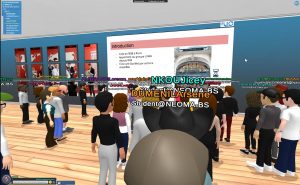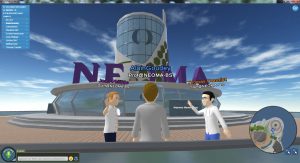The persistent virtual campus is a digital place accessible at a distance without health constraints that lives in your presence, but which also lives on even when you are not there.
By Alain Goudey
Professor & Chief Digital Officer
NEOMA Business School
LinkedIn
 The NEOMA Business School persistent virtual campus is represented by an island called Laval Virtual World operated by our partner Laval Virtual on which we run the main building of NEOMA, located on the top of the hills. When you connect to this world, the building is highly visible and recognizable thanks to the visual of the logo. Our building contains more than 40 meeting spaces and offices, an auditorium that can accommodate several hundred people and offer several classrooms on the ground and first floors for any kind of teaching class. It is also possible to take the benefits of the view on the whole island from the terrace of the building.
The NEOMA Business School persistent virtual campus is represented by an island called Laval Virtual World operated by our partner Laval Virtual on which we run the main building of NEOMA, located on the top of the hills. When you connect to this world, the building is highly visible and recognizable thanks to the visual of the logo. Our building contains more than 40 meeting spaces and offices, an auditorium that can accommodate several hundred people and offer several classrooms on the ground and first floors for any kind of teaching class. It is also possible to take the benefits of the view on the whole island from the terrace of the building.
The entire world is accessible for all of our community: staff and faculty members and the 9,000 students. You connect by creating a personalized avatar to attend work meetings, conferences or classes.
The project finds its roots in 4 dimensions: the need for proximity, for spontaneity, the maturity of the technology and the maturity of our school as an organization that has already began its digital transformation.
- The first one was our need of creating proximity even being physically distant. At NEOMA, we have several programs that run on distant campuses. For instance, our Program Grande Ecole is located both in Rouen and Reims and concerns more than a thousand of students for each year. For years we were thinking on how to create a team spirit for the entire cohort, despite the distance.
- The second one is the need of having spontaneity and fluidity in the exchanges while being distant. During the first lockdown we have measured the limits of traditional Visio conferencing tools. Indeed, we have identified two limits of these tools. The first one is individual since the individual is finally disembodied and focuses on his or her physical appearance through the webcam, which in the end generates a lot of fatigue called the “Zoom Fatigue”. The second limitation concerns group work, where alternating briefing phases and work in smaller groups is quite difficult to organize. There is no randomness, no spontaneity in the exchanges, everything has to be extremely planned. The persistent virtual campus, by mobilizing the theories of embodied cognition and extended self, responds to these issues because, ultimately, communication, learning and language are processes of a sensory-motor nature, and the individual finds himself embodied in the virtual world in the form of his avatar. Be connected to our virtual persistent campus is “as if” you were in the real life of a campus. You can meet unexpectedly colleagues, you can exchange informally with other people, you can improvise your groups of students while running an exercise or exchange sticky notes during a creativity session… you really import your habits thanks to the reproductivity of cognitive schemes you usually run on a physical campus.
- The third one relies on the maturity of the technology itself: in 2003, Second Life was born as one of the first persistent virtual universes with the promise of a “second life in the form of an avatar in a virtual societal simulation”. The platform was a great success with several million subscribers before falling into oblivion. During this period, some research had been carried out on the interest of a persistent virtual universe in terms of pedagogy with, for example, the University of Leicester. Today you can access several platforms that run persistent virtual world. However, we have decided to go on the one that met our needs the best in terms of: digital inclusivity (no need to have the very last computer for gaming), professionality (the platform is clearly oriented for business with several functions of sharing documents/screens, not gaming), massiveness (you can gather thousand of people at the same time in the world and dozens in a room), etc.
- And last but not the least, NEOMA has had the maturity of an organization that has already began its digital transformation. Of course, we know quite well the world of immersive technologies as we have already worked with our actual partner and in 2016, we launched the very first virtual reality-based case study in management. This project seems today the logical continuity of our first use of VR in higher education in management. The creation of the persistent digital campus is part of NEOMA Business School’s digital transformation strategy and aims to offer new educational and collaborative work approaches.
We were thinking of adopting this new tool even before the crisis but the coronavirus context has drastically accelerated our path.. Thanks to this persistent virtual world we want to hybrid the positive sides of both digital and presential contexts in an interesting alternative of teaching distant learning.
How do we manage the quality of this tool and how do we monitor the activity?
Since a couple of years, we have adopted the design-thinking based philosophy of “test and learn” as part of our innovation strategy. It means that we are in a continuous assessment of the experience inside the virtual campus.
 First of all, we measure how the platform is perceived. Some qualitative interviews have been conducted to assess the experience and deeply understand how participants felt about this innovation: what did they expect, how they feel, what could be improved, etc. Moreover, systematically, each participant has been asked to complete a questionnaire to measure satisfaction, the quality of the experience, the ease of use / usefulness of the tool, the future usages, etc.
First of all, we measure how the platform is perceived. Some qualitative interviews have been conducted to assess the experience and deeply understand how participants felt about this innovation: what did they expect, how they feel, what could be improved, etc. Moreover, systematically, each participant has been asked to complete a questionnaire to measure satisfaction, the quality of the experience, the ease of use / usefulness of the tool, the future usages, etc.
Secondly, we assess each seminar in details on a more pedagogical perspective with questions on the academical content, what the students enjoyed or would like to be enhanced, skills development, organization of the seminar, etc.
Thirdly, my team assists other teams of NEOMA, Professors or even students in the adoption of the persistent virtual campus. Thanks to this daily technical assistance it is also a really good channel to gather up really precise feedbacks on how to improve the platform.
The sources of quality evaluation are numerous, so that we have regular team meetings dedicated on how to enhance the quality of the experience inside the virtual campus.
How things are evolving? What feedbacks do we implement and how?
Thanks to our “test and learn” approach we can identify a lot of possible improvements of the tool.
This exchange is fluid thanks to collaborative tools we have set up between our organizations in order to be as real time as possible. The result is that within two months a couple of patches have been made and bugs tracked for an even better experience. We are also looking on the entire ecosystem to continuously improve the ease of use of the avatars, the emotional interactions, and of course the impact of the virtual experience on the real learning progress of our students!

0 Comments